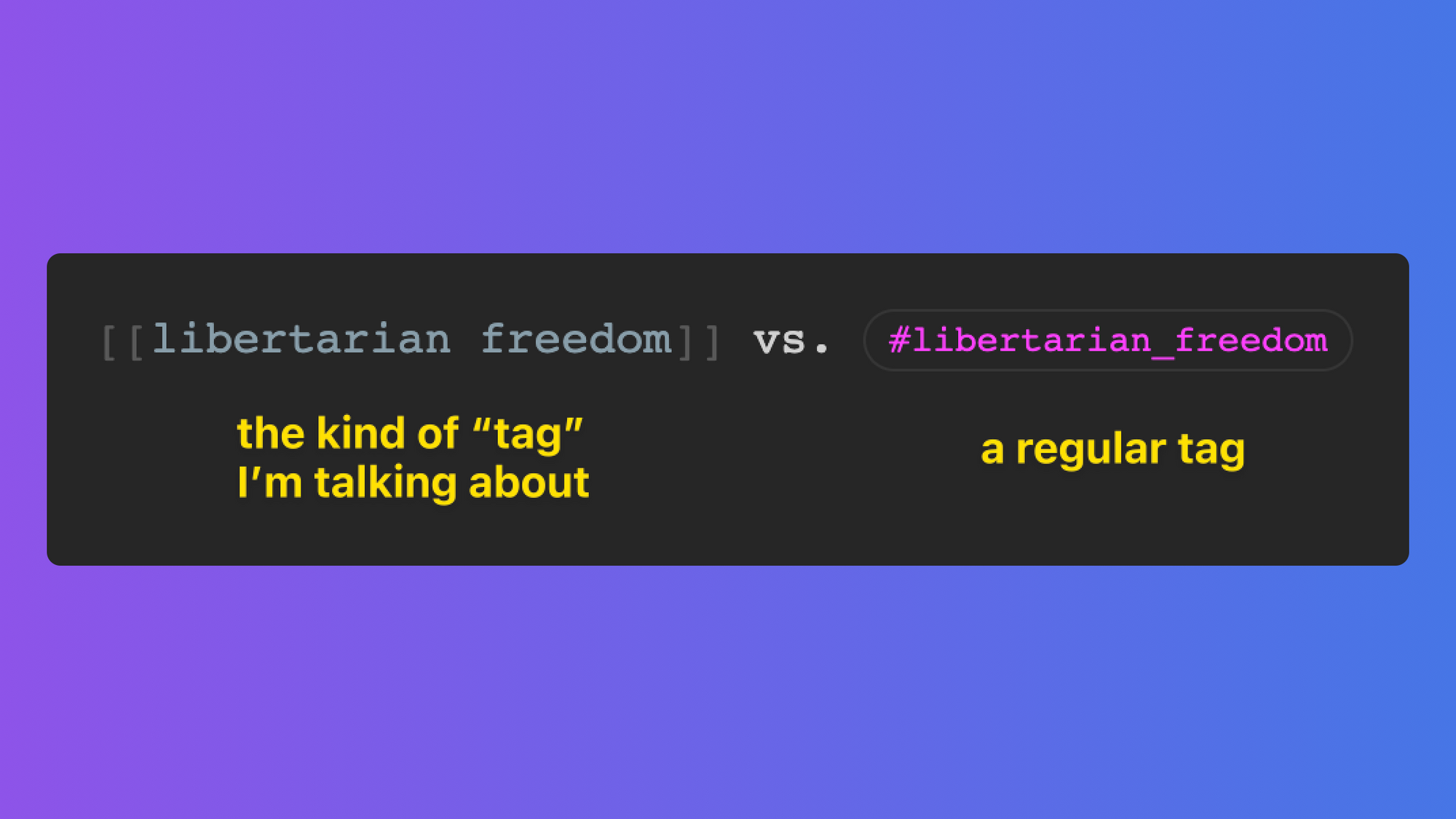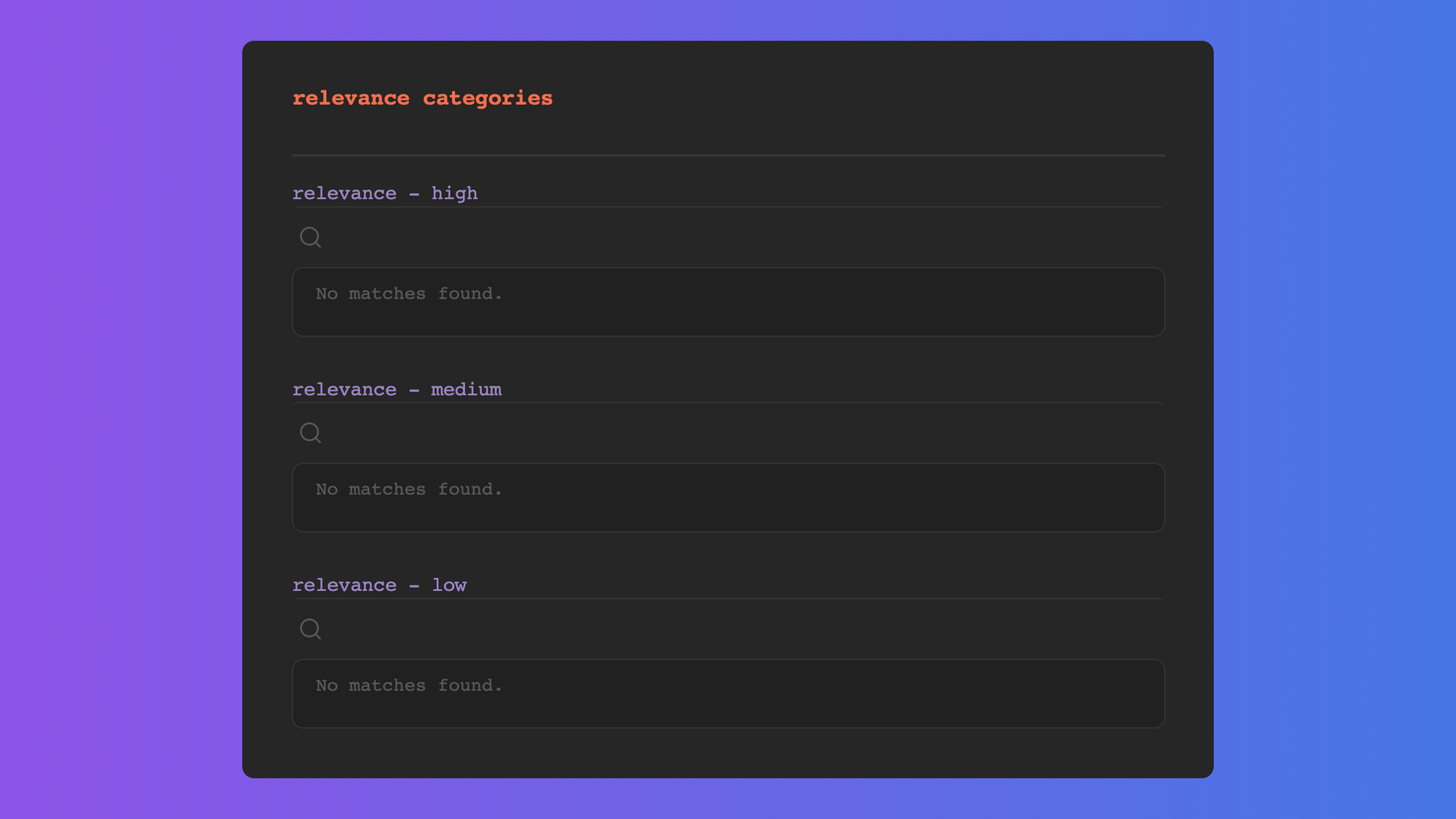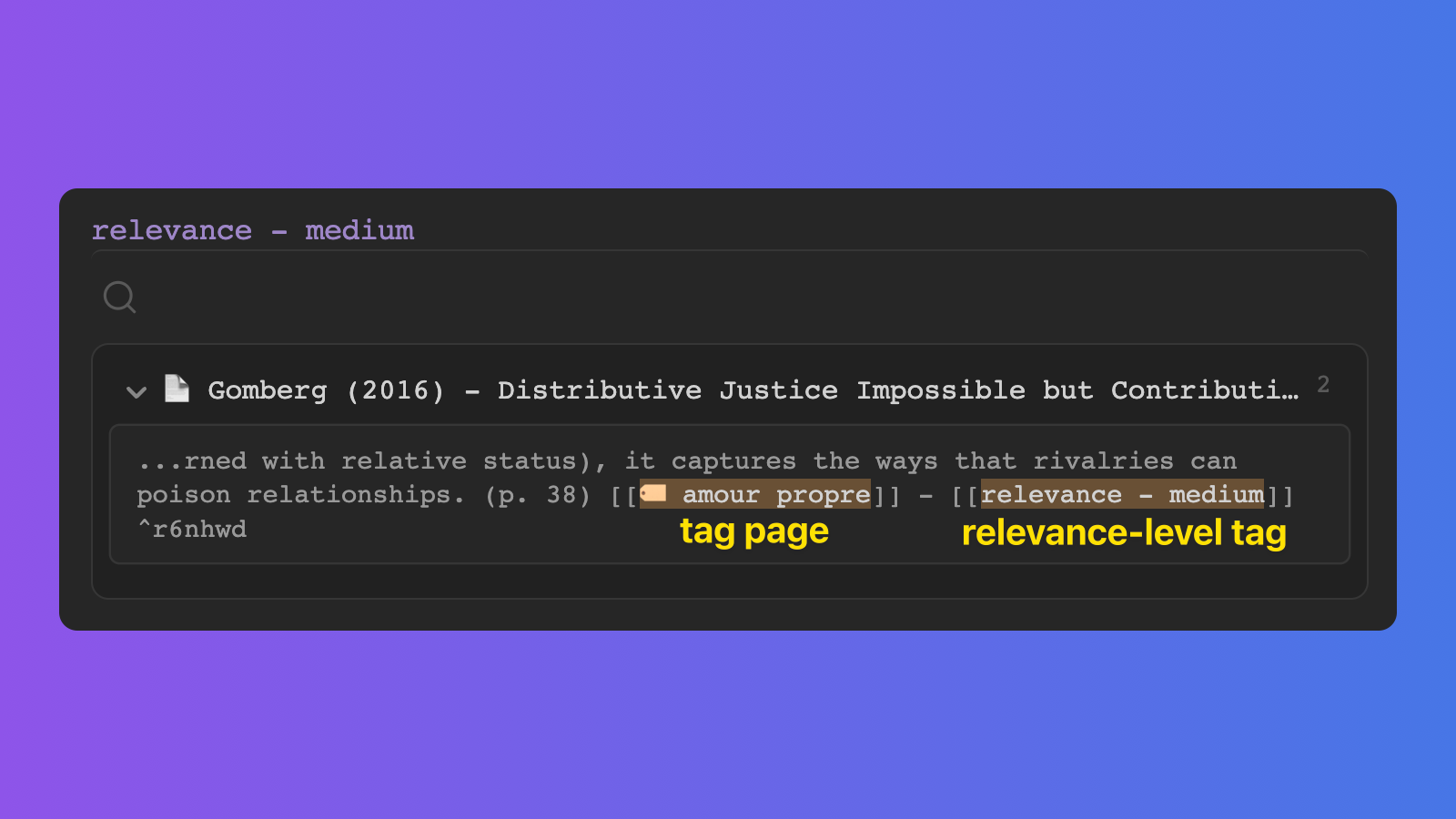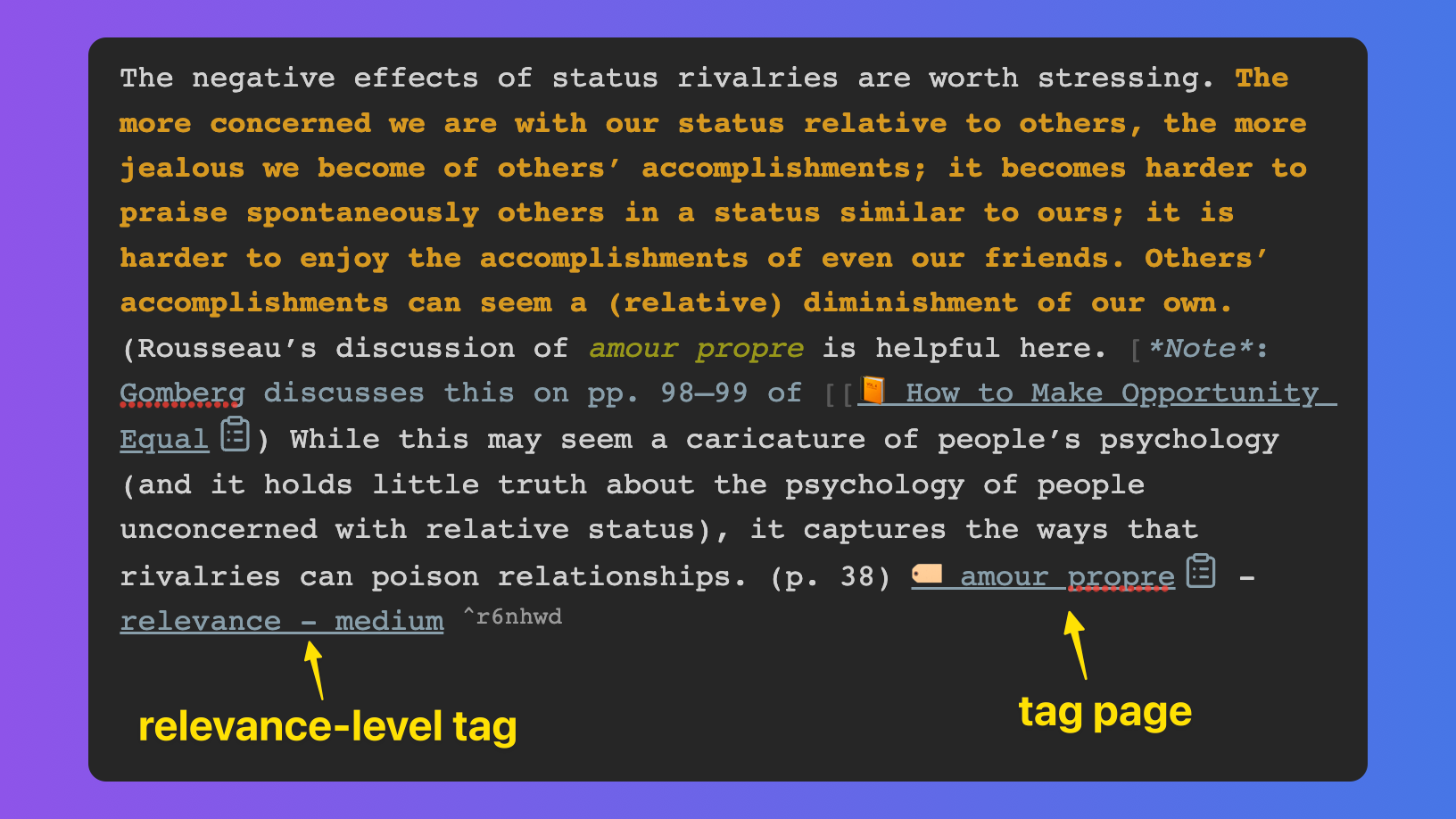[for Collider editors to view] TITLE - Relevance-level tagging: a "backlinks plus" approach to keeping track of information you might use in the future
What should you do when you come across information that is not related to a project you're currently working on but might become relevant to one in the future?
My preference is to capture that information in my own words, in the form of what many call a "permanent note," and then add it to a Folgezettel in my Luhmann-like Zettelkasten. (A Folgezettel is a sequence of notes, the importance of which I discuss in this video).
However, if I'm interested in simply keeping track of places where information related to a particular idea is discussed, I use something I came up with a few years ago: relevance-level tagging.
Relevance-level tagging (RLT) is a form of backlinking but without the problems that typically accompany backlinking. More specifically, it's a speedy way of using backlinks and queries to present information relevant to a topic in a way that sorts that information based on the level of its relevance to the topic.
Note: in what follows, the app I will talk about most is Obsidian, but much of what I lay out below could also be done in other apps that that have backlinking as a feature and let you build your own queries, such as Logseq, Roam, and Tana.
The "backlinks only" approach
Let's say you're looking at a page in your Obsidian vault that contains your highlights from and notes about a book. You decide you want to start keeping track of passages related to the (deeply misguided) right-libertarian understanding of freedom and the social conditions required for people to be free.
Next to the passage, you could type two left square brackets ("[[") followed by the term "libertarian freedom." Click on that newly created link and it becomes a page in your vault. I'll be referring to such a page as a tag page (Bryan Jenks and Curtis McHale use the term "tag notes" for the same thing). From that point on, whenever you come across material related to your [[libertarian freedom]] tag page, you could type "[[libertarian freedom]]" next to it. Doing this amounts to "tagging" the material as relevant to a certain topic.

The link to the tag page—[[libertarian freedom]]—functions like a tag in that it collects links to that topic in one place. That one place is the backlinks section of the topic page.
The only problem is that the backlinks section kind of sucks.
Problems with the backlinks section
If you're using backlinks when doing intellectual work over the course of years or even just a few months, the backlinks sections of your notes eventually become cluttered with too many links, causing you to feel overwhelmed each time you look at them. It's just a matter of time before you stop looking at the backlinks sections altogether.
Moreover, even if you could overcome your aversion to looking through a tag note's cluttered backlinks section, you would in most cases have to click on the links and scroll through the linked-to pages to find the material relevant to the topic of that tag page. That's because in Obsidian and plenty of apps similar to it, backlinks are links to entire pages rather than to just the most relevant parts of those pages, to the blocks containing the tag-page links you've added to them.
The main problem with having to click and then scroll through linked-to pages to find the relevant material is that it amounts to a form of context-switching that can make deep, focused work difficult to maintain. (Note: you could avoid the bulk of this sort of context switching by using apps like Roam, Logseq, and Tana, the backlinks sections of which contain links to blocks and thus to the most relevant parts of the pages you have tagged with tag pages, but there would still be reason to use RLT to sort those most relevant parts.)
The supposed solution: be very selective
Some might think the way to solve this problem is to be very selective when it comes to typing tag-page links next to material relevant to tag-page topics. That is, it might seem the solution is simply to add a tag-page link only to material that's super-duper relevant to that tag page's topic. That way the backlinks section of a tag page would contain links only to the most important material.
The problem with this supposed solution, at least in my case, is that whenever I reviewed information on an Obsidian page for a text I had finished reading, I frequently found myself thinking, “Maybe right now this material does not strike me as being super-duper relevant to a particular topic, but later I might discover it is, in which case it sure would be nice to have it linked to the topic page so that I don't have to go hunting for it elsewhere.”
I was usually anxious when I found myself asking this question. Typically what happened is that I would either (a) backlink the material to a topic page but then worry that I had just added yet more clutter to the backlinks section of that topic page or (b) not backlink the material but then worry that maybe I should have.
The "backlinks plus" approach (RLT)
Although there are problems with backlinks sections in an app like Obsidian, backlinks themselves are useful—provided they are supplemented with relevance-level tags and the right kind of queries.
You can think of the backlinks section of each Obsidian note as a query—a search—plus the results of that query. The query in each backlinks section tells Obsidian to return results that match just a single search term: the title of the note that backlinks section is part of.
If we instead want Obsidian to not only (a) pull together in one spot all notes that contain a link to a block on a particular topic page but also (b) group the links to those blocks based on their level of relevance to the title of the topic page, then we need to create our own queries.
Below is what a section containing relevance-level queries looks like on a tag page in my Obsidian vault (again, to see the query language behind what's seen below, go here).

And here's what a "relevance - medium" section looks like on a tag page—[[🏷 amour propre]]—where the "relevance - medium" query has returned a single search result:

Getting information from one page to show up as a search result in a relevance-level query on a tag page is simple: next to the the piece of information, type (a) a tag-page link and (b) a relevance-level tag, as shown below.

When you put a tag page next to a piece of information, you're indicating that the information is relevant to the topic of that tag page. When, in addition, you put a relevance-level tag next to that same piece of information, you are indicating how relevant you see that material as being to the topic of the tag page.
As you can see above (in the screenshot above the previous one), the part from the [[📙 A Sense of Inequality]] page that the query returns as a search result doesn't contain a whole lot of information: it's just the two search terms—the [[tag page]] and the [[relevance-level tag]]—preceded and followed by a couple lines of text. In almost all cases, you will want to see more information than that. Fortunately, that's easy to do. There are a number of options when it comes to disclosing more information above and below the search terms, three of which I lay out in the detailed instructions on how to implement RLT.
The advantages of RLT
One advantage of using RLT is that it speeds up the work of completing a project. Reviewing relevant material via queries that sort the material based on how relevant it is to a particular topic is faster (and less frustrating) than having to review material in the backlinks section. When it comes time to write something related to the topic of a particular tag page, I can start by focusing on the material I have tagged as being of high relevance, move on to the material tagged as being of medium relevance, and then probably just ignore material tagged as being of low relevance.
A second advantage is that you can view each query's search results without having to open the pages the results are pulled from, thus reducing the sort of context-switching that erodes attention.
To explain two other advantages of using RLT, I need to say a little about my use of the [[relevance - medium]] and [[relevance - low]] tags.
The [[relevance - medium]] tag is the one I use the most. Yes, assigning that tag to too much material reintroduces the problem of clutter—this time where the "relevance - medium" query is on a tag page rather than in that page's backlinks section.
But I'm fine with that because using RLT has another advantage: when I tag material with not only a certain tag page but also a relevance-level tag, I rarely find myself feeling anxious about whether to tag material that's relevant to a topic page.
As for the [[relevance - low]] tag, I use it a bit more frequently than the "high relevance" one. You might be wondering why use it at all? One reason is that maybe, just maybe, low-relevance material will be useful for a future writing project. I know it is unlikely that I will use the material tagged as being of low relevance, but if it is even a tiny bit probable that I will use certain material, I usually put a [[relevance - low]] tag next to it.
Of course, what I have just said is what you could expect someone who has fallen victim to the Collector's Fallacy to say so as to justify collecting just about every bit of information they come across. But it's not the Collector's Fallacy that leads me to collect information that is of low relevance to a topic—I am not driven by the mistaken belief that the more information I collect, the more knowledgeable I will become.
Instead, the thought that certain low-relevance material might be useful for a future writing project amounts to an itch I haven't been able to get rid of. I have reduced the frequency with which I scratch that itch—I've been using the [[relevance - low]] tag a bit less than I did at first—but the itch remains. Using the [[relevance - low]] tag scratches that itch without really adding to the clutter of search results (at least not to the ones returned by the queries for the other two levels of relevance). Put differently, scratching the itch adds "noise" to my notes without reducing the "signal." I use the [[relevance - low]] tag to scratch that itch as much as I do to non-anxiously collect information that might be useful for a future writing project.
RLT isn't what you should be doing most of the time
While RLT can be useful, it should be done in the service of—not as a substitute for—more important work, such as building a Luhmann-like Zettelkasten or working on a well-defined writing project. Otherwise you're doing something about as unimportant as merely collecting and tagging texts, videos, and podcast episodes (which happens to be yet another itch I too often scratch).